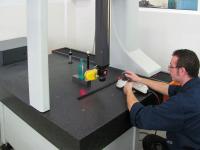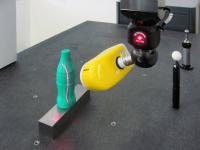More efficient production by using multi-sensor metrology from Nikon

Photo by Nikon Metrology NV
Omco Group, the largest manufacturer of glass container moulds in Europe, and perhaps in the world, is leading the way within its industry by using laser scanning multi-sensor metrology to digitise customers’ bottle designs, shortening the lead-time from receipt of order to delivery of the finished moulds.
Manufactured by Nikon Metrology, a pioneer in 3D laser scanning and part of the renowned Nikon group, the LC50Cx digital line scanner is fitted to a C3V co-ordinate measuring machine (CMM) in one of Omco’s seven mould shops, located in the north east Romanian town of Iasi.
Intended for mass production of glass bottles and jars, the cast iron moulds are sold mainly to fast moving consumer goods (FMCG) manufacturers and their supply chains in the beverage, food, pharmaceutical, cosmetics and tableware industries. Anyone reading this will almost certainly have consumed a soft or alcoholic drink from a bottle produced in an Omco mould, as just a few well-known users are Coca-Cola, Pepsi Bottling Group, Heineken, Carlsberg, Absolut Vodka, Bacardi and many châteaux in Champagne and elsewhere.
Glass container producers face tough consumer demands as well as rising energy costs and increased competition from alternative packaging, notably plastics.
As a consequence, glass mouldsuppliers have to meet exacting customer requirements for top quality and short lead-times, whilst maintaining competitive prices. One way that Omco achieves these objectives is by adopting new methodology near the start of the mould manufacturing process, in which its new Nikon Metrology laser scanner plays a central role.
The first stage in a contract is for Omco to input a customer’s design details, which may include decoration and perhaps also lettering that has to be superimposed on a bottle’s curved surface. Such bespoke data arrives as a drawing or electronically as a DXF file. Staff at the Iasi facility processes this information and machines a sample of the bottle using CNC equipment such as a DMG / Mori Seiki machining centre, a Doosan lathe and a Baublys engraver. The result is a physical facsimile of the intended bottle from which an epoxy resin copy is made.

Photo by Nikon Metrology NV
In the next step, conventional practice and the process route driven by the Nikon Metrology laser scanner differ significantly, as Alexandru Geanta, Quality Manager at Omco’s Iasi site, explains. “Historically, we sent the resin model to the customer for approval, most often by air due to the urgency of such projects. However, flying a package from Romania to Argentina, for example, took eight days door-to-door and the model then had to be evaluated and passed off at the other end. Overall, it used to take up to 14 days to receive any changes needed to the design plus the go-ahead to start producing the set of moulds.
“Now, we simply scan the resin facsimile from several angles on the CMM using the LC50Cx mounted in a Renishaw PH10M motorised indexing head. The resulting point cloud data, an exact digital copy of the physical model, is reduced in size to around 80 MB by converting it into IGES format. This is sent electronically to the customer and can be opened on many different CAD platforms.
Turnaround is much faster, as approval is usually received the same day, or in 48 hours at most. In an alternative scenario, we use the laser scanner right at the start of a project to reverse-engineer a sample bottle sent to us by a customer which no longer has drawings and / or CAD data of the design. The scan data is emailed as an IGES file directly to the customer for approval, so there is no need to make a resin facsimile.”
Mr Geanta went on to explain that the customer is interested not only in the visual appearance of the design but also its exact dimensions. The latter are more easily extracted from digital data than by measuring a sample or model. If any small changes are needed to a dimension or indeed to the design itself, these are communicated quickly by email or over the telephone.
It is the ability to compress the front end of the mouldmaking procedure that allows around two weeks to be saved. When approved by the customer, the IGES file is loaded into a Delcam CAD/CAM system at the Iasi factory and cutter paths are generated and post processed for CNC machining the moulds. Inspection and assembly of the mould set then takes around four weeks, so total lead-time is reduced by one-third, which translates into a considerable commercial advantage in this competitive business.
Not only is time saved but cost is also taken out of the approval procedure, as air freight charges to customers worldwide are avoided, often cutting expenditure by thousands of Euros.
For further information visit www.nikonmetrology.com
News Categories
- » NEWS HOME
- » Automation & Robotics
- » Industry 4.0
- » Material Handling
- » Sensors
- » Quality & Testing
- » Machine Vision
- » Laser & Optics
- » Metalworking
- » Motion Control & Drives
- » Hydraulics & Pneumatics
- » Process Industry
- » Renewable Energy
- » Agriculture
- » Home & Office Furniture
- » Environmental Tech

